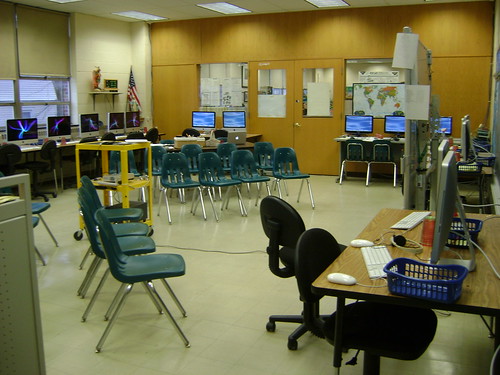Revisiting September
In September, I started classes by introducing the students in sixth through eighth grade to ISTE NETS for Students. I think it is essential to get the students thinking about the goals of their computer education and assist in evolving the program. I am trying this for the first time with my seventh grade students and hope to go through the process with the sixth and eighth graders. The first step was to review the ISTE NETS. I introduced our New Jersey State standards which are based on the ISTE standard. The students have existing work groups. Each group received a short list of projects that we've completed to date (see Project List below).
Small Group Work
The group is dividing the standards into three parts: state standards, first three NETS, second three NETS. A group leader goes through the project one part at a time. The students search and determine what goals they believe they met through the project. They are recording their selections with x's in a spreadsheet.Individual Work
The individual portion of the work involves creating a personal reflection in a word processor. I am trying to review old skills and introduce some new skills. This provides a great vehicle for content. The students will create a "proper" heading with ONE tab set following the school's guidelines. They will indent their paragraphs using the hanging paragraph setting and the ruler. There will be one short paragraph per project. They will reflect on what they felt they learned through the project, what they liked, and what they did not like about the project. They will write a final paragraph telling me what type of project they would most like to work on next with a specific example and tell what standards we would be meeting through the project. The paragraph will be double-spaced with proper spacing between words and after punctuation marks. It is to be proofread for good spelling and grammar.
Whole Group Reflection
We will end the process with a group reflection on projects suggested by the students and choose at least one project to complete in the last trimester of school. I am hoping to find great value in the process and continue to do this every year.Project List
Project 1
A. Learn to create and animate a fish and your choice of animation.
B. Choose your license from: copyright, creative commons, and public domain.
Project 2
A. Practice creating citations for the Daughters of the American Revolution essay resources.
Project 3
A. Create “Something You Probably Don’t Know About Me” presentation.
B. Present your presentation to the group.
Project 4
A. Create “Evidence of Advent” photos and select photo for iMovie. If you did not assist in this project, explain what project you were completing and why it took you extra time.
Project 5
A. Discussion about “What To Do If You Find Upsetting Information on the Internet”.(Boys/Girls)
Project 6
A. Create Dice, Country, and Donation Spreadsheets.
B. Write Country and Donation Analysis.
Project 7
A. Learn to determine who was responsible for the DAR web sites.
B. Determine in small group and present to whole class on the value of the information on a selected web site.
C. Write a letter to the creator(s) of your web site.
Image Citation:
Photo (c) 2011 Ann Oro.

